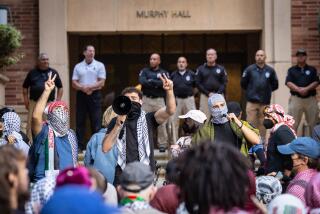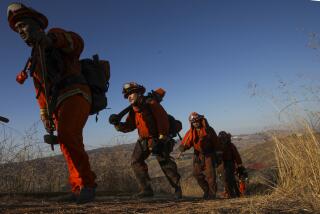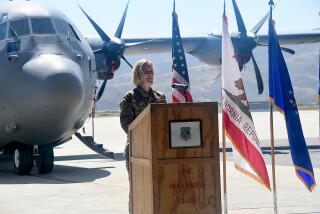New Guard Head Pledges Response Within 24 Hours : Military: Commander has streamlined crisis center so that decisions can be made swiftly and materiel is available. Organization was criticized during the riots for delays and not having ammunition ready.
SACRAMENTO — In the aftermath of last year’s riots in Los Angeles, the commander of the California National Guard retired with the indirect encouragement of Gov. Pete Wilson.
Although 6,000 Guard troops performed superbly and won high praise for their work, the Guard’s top-level command system was criticized for causing confusion and agonizing delays in providing ammunition and riot gear to the troops on the streets.
The new commander, Maj. Gen. Tandy K. Bozeman, vows that that will not happen again.
“We are doing intensive work to be absolutely certain that if the situation reoccurs in Los Angeles, the Guard is absolutely ready to meet its commitment to its state mission,” Bozeman said. “We consider (a potential second riot) a worst case and that is what we are planning for.
“We’ll get the job done,” Bozeman said in the soft drawl of his native Alabama, promising that troops with loaded guns would be on the street within 24 hours of being called to duty.
At his new post for less than two months after being recruited by Wilson, Bozeman, 53, outlined his plans during an interview last week with The Times. Bozeman has had wide interests and careers outside the military. He is an airline pilot, motorcyclist, former news photographer and holds a doctorate in archeology.
Until his appointment Dec. 2, Bozeman had been commander of the 5,000-member California Air National Guard, a part-time post. He becomes the first Air National Guard officer to command the full 26,000-member California National Guard, chiefly an Army organization.
Bozeman, who owns a home in Thousand Oaks, took a leave of absence from Trans World Airlines to accept the $103,000-a-year appointment.
In the interview, Bozeman, a reputed taskmaster with an easy-going demeanor, said he has put into motion the first steps needed to ensure no delays in case of an emergency call to the Guard for riot duty or other crisis. For starters, storage of ammunition and riot equipment has been decentralized so that it can be available without delay to Guard members.
The Guard’s headquarters “crisis center” has been streamlined so command decisions can be made swiftly. Certain military police units in Southern and Northern California have been pre-selected for extra rapid deployment.
“We are saying we can have the lead force on the street in 24 hours,” Bozeman said. “That is a reasonable time frame. If we can do it faster, so much the better. If the governor says he wants a different time criteria, we’ll do that.”
Bozeman is well aware of the criticism that rained upon his predecessor.
The former commander, Maj. Gen. Robert Thrasher, an appointee of former Gov. George Deukmejian, was told last winter that Wilson likely would appoint a new adjutant general, according to a well-placed Guard source. Thrasher offered to resign, but Wilson asked him to stay until a successor was found, the source said.
Then the riots occurred and an investigation ordered by Wilson severely criticized the performance of top-level Guard officers. “The governor never said: ‘You’re fired.’ But he didn’t ask Gen. Thrasher to stay on from now until kingdom comes,” recalled an assistant to Wilson.
Although the Guard’s citizen-soldiers from throughout California received high marks for swift deployment to Los Angeles and for their performance there, the troops were unable to quickly move out to the streets because of command confusion and delays in receiving ammunition and other equipment.
While many had no ammunition, others were given bullets by civilian law officers. Some Guard members were exposed to harm without full protection and some reported being taunted by roving gangs.
“It happened to us in north Compton,” recalled Brig. Gen. Robert J. Brandt, a veteran guardsman and now assistant adjutant general. “In this case, they drove up next to us at a stoplight and said: ‘You guys don’t have any ammo.’ ”
Brandt said his aide then pulled a loaded magazine out of his gun and displayed the ammunition to the hoodlums. That ended the incident.
In the 1960s and ‘70s, guardsmen throughout the country received civilian crowd control training to cope with unarmed anti-Vietnam War protesters, instruction that diminished as the war ended and priorities shifted.
But nearly two decades later, the Los Angeles riots erupted, with shootings, arson and looting. This new dimension of lawlessness caught the Guard--and civilian authorities--unprepared.
That will not happen again, Bozeman said.
As part of the preparation for riot duty, Bozeman said the Guard will soon be trained in tactics of how to “operate in an urban guerrilla environment of drive-by shootings and gangs who are heavily armed.”
Although details have to be worked out, Bozeman and Brandt said they want to emphasize to their troops the delicate nature of deployment in a civilian environment, and that the tactics they learned for the military battlefield do not always apply.
“Even though they may be trained, we want to take some (extra) time to brief them because they are going to go out and may be called on to use lethal force,” Bozeman said. “We want the proper use of lethal force to be the freshest thing in their minds.”
Bozeman said he believed that during the riots every state and local official had a different notion of how soon the Guard would arrive after Wilson called it to duty. But he said no one was correct, in part because the Guard had not set a response deadline.
“Without adequate planning, the National Guard got cold-started in the worst possible circumstance,” he said. “No warning at all. Boom.”
He said during the next few days he will present the 24-hour deadline to state and local authorities and seek to make certain that the Guard’s capabilities are understood. He said he plans meetings with Wilson, Los Angeles Police Chief Willie L. Williams, Los Angeles County Sheriff Sherman Block and other emergency services and law enforcement officials.
“We are not an instant police force,” Bozeman said. “The truth is, to bring (Guard members) back from their civilian work and get him into the military and ready to go in 24 hours is remarkable.”
Bozeman said Wilson did not directly raise the issue of the Los Angeles riots when he appointed him in December.
“He had no political agenda or marching orders for me other than do a good job,” Bozeman said.
Away from the Guard, Bozeman indulges himself in long tours on his motorcycle, something that “aspiring fighter pilots (do) when they get old.”
As a teen-ager in Alabama, Bozeman was a photographer for newspapers. He said he paid for his undergraduate education at the University of Alabama by working as a news photographer who covered Martin Luther King Jr. and the civil rights movement in the late 1950s and early ‘60s.
In 1982, he received a Ph.D. in archeology from UC Santa Barbara. He is an unpaid member of the archeology faculty at Indiana University, where he critiques student research proposals.
More to Read
Get the L.A. Times Politics newsletter
Deeply reported insights into legislation, politics and policy from Sacramento, Washington and beyond. In your inbox three times per week.
You may occasionally receive promotional content from the Los Angeles Times.










